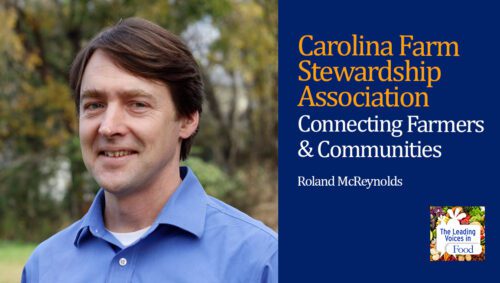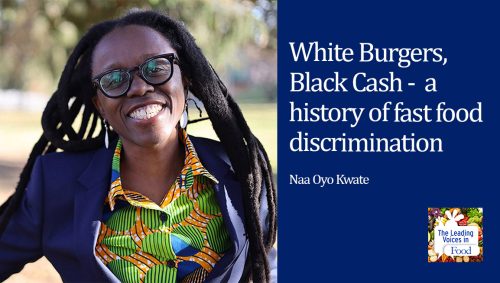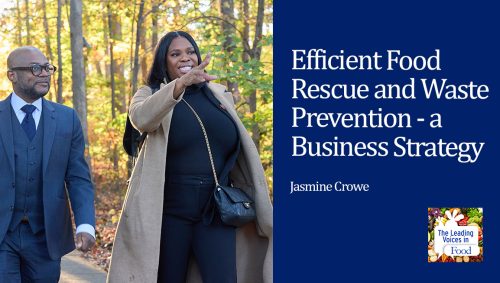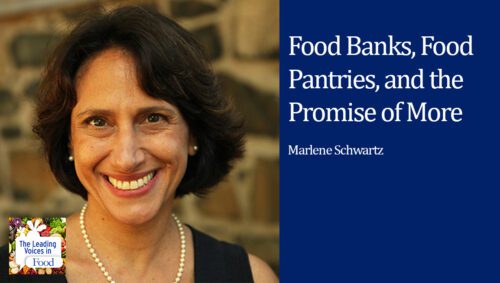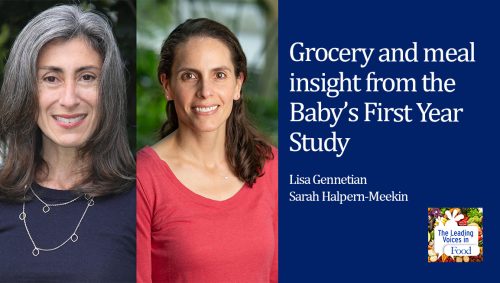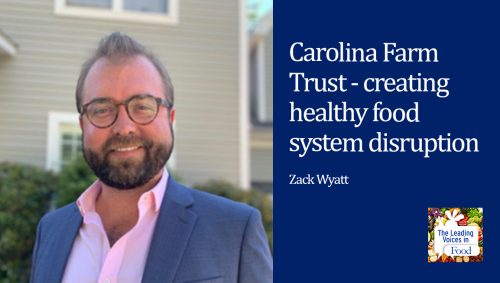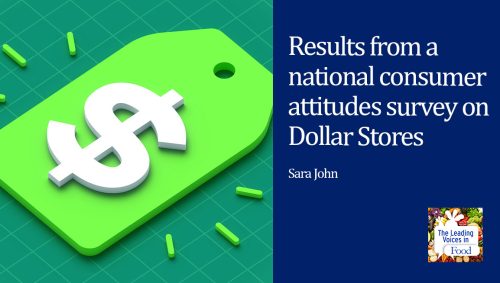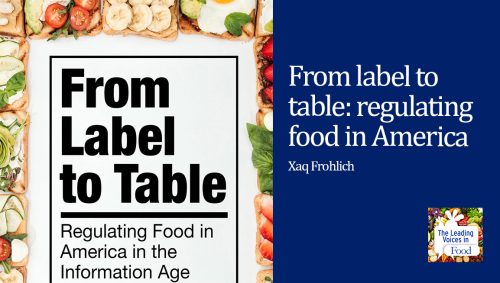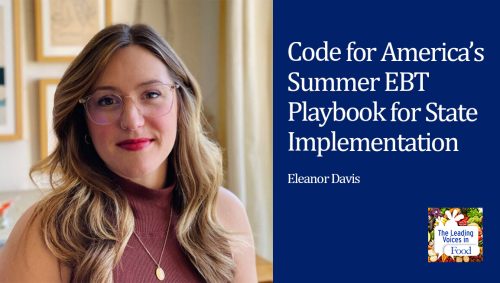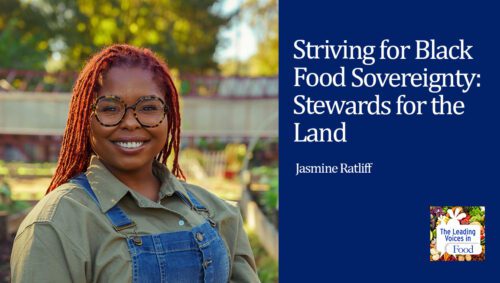The Leading Voices in Food
E176: Insights from a nationwide survey of hunger relief organizations during COVID
During the early days of the COVID-19 pandemic in 2020, much of the US was in lockdown. Many people had lost jobs or could not work from home during that time and struggled to pay their bills. Shortages of food and other basic necessities were common. Many people needed help during this time. Charitably-funded volunteer staff organizations like soup kitchens and food pantries suddenly found themselves on the front line of a massive ongoing food relief emergency. Many of them did heroic work. We’re speaking today with the co-authors of a new report titled, “The Impact of the COVID-19 Pandemic on US Hunger Relief Organizations, from August and November of 2020.” Gizem Templeton is a researcher at Duke University’s World Food Policy Center. Alison Cohen, formerly of WhyHunger, is a research consultant on the project. And Suzanne Babb is the director of US programs at WhyHunger.

Gizem Templeton is a Research Associate at the World Food Policy Center at Duke University’s Sanford School of Public Policy. She earned her PhD in Food Science and Human Nutrition from the University of Illinois at Urbana-Champaign. Her dissertation focused on the use of nanotechnology in peanut allergen and acrylamide detection while utilizing a biodegradable corn-based sensor platform. She is a native of Turkey and has been living in the States since 2011.
Alison Cohen is a former Senior Director of Programs at WhyHunger.org. She has more than thirty years of experience supporting grassroots-led organizations in rural and urban communities around the world in strengthening social movements that address the root causes of hunger. She is currently coordinating a process to build a national movement for the right to food. She holds a master’s degree in sociology from Virginia Tech.
Suzanne Babb is Senior Co-director of U.S. programs at WhyHunger.org. She develops and oversees the implementation of WhyHunger’s domestic strategies: Transforming the Emergency Food System, Black Food Sovereignty and Labor and Economic Justice. Suzanne helps to convene and support regional and national networks and alliances of emergency food organizations working to ensure the right to food by addressing the systemic inequities resulting in hunger and poverty. Additionally, Suzanne supports the growth of BIPOC led food sovereignty organizations, networks and alliances by mobilizing resources and providing technical support to aid in the creation of legislation, infrastructure and institutional structures grounded in equity and justice. Originally from Montreal, Quebec, Canada Suzanne has many years of experience working on community development
Interview Summary
So Gizem, let’s begin with you. Can you tell our listeners about the survey itself and what WhyHunger hoped to accomplish through this work?
Gizem – Sure, Kelly. So as a research partner for WhyHunger, we wanted to survey hunger relief organizations, which are food banks, food pantries, soup kitchens, as well as hunger advocacy organizations during the pandemic in the summer of 2020. Our goals were twofold. First, we wanted to document what was happening in terms of pandemic impact and response. And second, we were interested to see what programmatic policy and food system recommendations they had for the future. All in all, over 240 hunger relief organizations from 39 states responded to our survey.
It was important to understand the impact on hunger relief organizations because these organizations are mostly dependent on charity donations of cash and food. Their operating budgets change from year to year. And, they’re staffed largely by volunteers who tend to be older individuals. So as you can imagine, the COVID-19 pandemic created a range of daunting challenges for them.
You may probably recall the many media stories with photos of long lines of people trying to get food during the summer of 2020. The hunger relief organizations in our survey said that demand for food and other services increased significantly. We heard that people who used to donate money were coming in to get food themselves. And also, that many families were struggling simultaneously with job losses, housing issues, and reduced access to food. Hunger relief organizations did everything they could to stay open. And we saw a lot of innovation to meet the demand, in this survey.
I mean, there is no question that hunger relief organizations gave their all for our society during the pandemic, but in their own words, they also questioned the country’s dependence on charitable donations to keep people fed. And survey responses highlight a need to strengthen the national social safety net and to focus on the root causes of hunger.
So Gizem, how did the hunger relief organizations grapple with these tremendous challenges during the pandemic?
Gizem – Yes, so first, all but two of the organizations who responded to our survey were able to remain open. But all of them had to make big changes very quickly to keep up with an almost overwhelming demand for food and new safety practices as more was learned about COVID. And we saw shifts to curbside pickup of food, some home delivery, and a few organizations were even able to offer client transportation for housebound individuals. Some hunger relief organizations made a shift to online ordering.
I would say the biggest challenge they faced was the loss of volunteers due to COVID risk. And they had to suspend some programming as a result of that. Many surveyed organizations said some of their volunteers and staff contracted the virus during this time. Another challenge was not enough refrigeration space for perishable food and storage for shelf stable food as the volume of food coming in increased to meet the demand.
And a big challenge, I would say, the organizations at times struggle with a lack of communication and coordination from the government that would’ve allowed them to prepare for changes to regulations, safety protocols, and federally sponsored programs like the Farmers to Families Food Boxes.
In terms of what helped them meet the demand, I would say philanthropic funding was key. Charitable funding for emergency food surged during this time and partnerships within and outside of the hunger relief world and increased local coordination were also big contributors to success.
It is clear that the hunger relief organizations did incredible work to support our society during this chaotic time. But we have to ask ourselves, does it make sense in a country as wealthy as ours that so many people had to turn to charity in order to have enough food?
So Alison, in your view, what were the most surprising and the most troubling and even the most hopeful things that you uncovered in the survey?
Alison – Well, I think the survey uncovered both troubling and hopeful things given that the entire emergency food system was thrown practically overnight into crisis mode. Because of the pandemic, we witnessed every single hunger relief organization pushed to its limits. And the ways in which the system was taxed during this time is not surprising given that for many working families, the local food bank has become a kind of free grocery store that helps to plug the holes in household finances year round.
For many decades now, the rate of food insecurity has not fallen below 11%. Food insecurity is, unfortunately, a way of life for far too many households. And as Gizem said, a majority saw an increase in need.
What we need to pay attention to is the way in which this increase in need was confounded by other issues that for many, were not experienced by or visible to hunger relief organizations before the pandemic. For instance, these organizations struggled with the government’s response to the pandemic, particularly the inconsistency and unpredictability of the response. The government, of course, was dealing with this magnitude of crisis for the first time itself. More than 70% of HROs said that in order to fill the gaps in government support, they turned to their own forms of communication and coordination with funders, local farmers and growers and other stakeholders, other community organizations.
This survey was unique in that we queried first responders, so to speak, to a food security crisis unlike anything we’ve experienced in the US at that scale. And our findings in the survey add to the reports and stories in the media, those that we all heard and saw, of the miles long lines of cars waiting in parking lots to receive food and the millions of people who found themselves needing a food bank for the very first time in their lives. And all of that exposed how inadequately we, as a society, are addressing the economic precarity of a majority of American households. And therefore, how in sufficiently we are working to end hunger in food insecurity in one of the wealthiest countries in the world.
But Kelly, it wasn’t all doom and gloom. There was a lot of hope, I think, that came through in the survey. And what I found particularly hopeful is that hunger relief organizations overwhelmingly embrace the both end of their missions. That is to ensure that folks who need it get healthy food now and to ultimately end food insecurity. And based on their responses, they have a multifaceted understanding of what it will take to do both and what the role in it should be. And I think that’s an incredibly hopeful point and something we should pay attention to.
Well above 60% of hunger relief organizations identified dependence on volunteer staff, dependence on individual and corporate donations as issues to be addressed. They also cited lack of government support and solutions to address the root causes of hunger such as unaffordability of healthy food, low wage jobs, unresilient food supply chains, and they called out as problematic the persistence of inequitable access to healthy food is a manifestation of structural racism in the food system.
But their clarity on where the deficiencies are in the system doesn’t end there. They have a strong vision for what they want to see happen and their role in it. These organizations are calling for increased sustainable and more flexible funding so they can get healthy food to people in the most dignified way possible. They’re also calling for a stronger social safety net. They want to see the increases that were legislated during the pandemic become permanent features of the social safety net, including universal free school meals. And they’re also advocating for snap changes such as more flexibility and broader access. And they’re calling for the descaling of government food nutrition programs. Instead, advocating for programs that address the intersections of food security, affordable housing, mental health, living wages, and childcare among other issues.
One respondent wrote in the following response, which was repeated by other respondents in their right end responses as well: “People need living incomes, ones that make it possible to provide both food and shelter. Emergency food network should not be used to prop up an inadequate system of income support.”
You know, Allison, as I’m listening to you, it’s so clear that this was an enormous challenge with so many implications for looking back on what was done and thinking about the future and what might be done. So it’s really helpful to have you talk about some of the permanent changes that could help for us stall or even avoid such a terrible crisis should something like this happen again.
So, Suzanne, let me ask you. The report presents the perspective that the US relies too much on charitable food, but if there’s philanthropic support out there for the charitable food system, why is this such a problem?
Suzanne – Well, there are couple of reasons for that. I think, firstly, the charitable food system cannot meet the need. I think then it’s important to think about what the charitable food system is based on, and although it has the best of intentions and is trying to fill a need, the majority of the system props up this dysfunctional system that relies on corporate waste. And far too often, these corporate donations are highly processed, filled with high fructose corn syrup, and are lacking in nutrition. And this helps to contribute to increased rates of chronic disease like diabetes and heart disease that disproportionately impact low income and BIPOC people. Also, the corporations that benefit from these tax write-offs in the process are notoriously the low wage employers who don’t pay people enough money and whose staff rely on food stamps and charitable food to feed their own families.
Another reason is that the right to healthy and nutritious food is a basic human right and governments bear responsibility to their citizens to fulfill these human rights. But the US has slowly reduced its role in fulfilling that responsibility, and instead have been putting it in the hands of charitable organizations that have been vulnerable, always relying on donations and volunteers. And this is just not a sustainable system.
The US hasn’t codified the right to food federally. There’s one state, the state of Maine that has done so in their constitution in 2021. And there are other states that are organizing and strategizing to do the same. I think, lastly, it’s important to remember that hunger is a symptom of poverty and poverty is a created condition. And the government has played a role in creating this condition and has a responsibility to be a part of the solution.
Thanks, Suzanne. So Alison, let me ask you one final question. The report offers up quite a wide range of recommendations for hunger relief organizations, also for philanthropy and for the federal government. Can you provide examples of organizations who are already implementing some of the recommendations? Could you talk about these and the opportunities that you see for a sustainable change?
Alison – Yes, yes, I’d love to. And I think that’s a really important part of the report and there’s much more in the report than I can say here during the podcast. So I would encourage folks to really take a look at the report, to hear more details, and to learn about very specific organizations and actions and activities that are happening.
So first, as Suzanne mentioned, yes, there’s a historical over-reliance on the charitable food system and that has gotten out of balance. Hunger relief organizations, philanthropy, and the government all have a role to play in correcting that imbalance. Some 50 years ago, these organizations were designed to be temporary and crisis related, but what’s emerged is a system that continues to need more and more bricks and mortar to mediate what has become a stagnant and alarming rate of food insecurity. And as we see in the results of the survey, many hunger relief organizations are expanding their strategies to include helping clients get access to government nutrition programs and policy and advocacy to improve federal nutrition programs. And a smaller, but I think growing subset of these organizations are beginning to address root causes of food insecurity such as low wages, poor working conditions, structural racism is a part of their mission.
For example there’s a soup kitchen called Neighbors Together that has been operating in Brooklyn, New York for more than 30 years. About 10 or so years ago, they began engaging clients in determining their own advocacy agendas through what they called their community action program. Their participants, all of whom are patrons of the soup kitchen, identified insufficient wages and barriers to safe and affordable housing as primary reasons they required ongoing food assistance. So they organized others in their neighborhood and are currently advocating with the city of New York and the state of New York to implement policies that address housing and wages.
And in Washington State, the state’s largest independent hunger relief agency known as Northwest Harvest is working to shift public opinion and change policies and practices that perpetuate hunger, poverty, and disparities while advocating for a right to food framing for statewide policies. They’re one of the states that is really engaged in hoping to amend their constitution to include the right to food as Suzanne mentioned earlier.
And one last example, and again, the report contains many others, is the Black Church Food Security Network. Their mission is to ensure food security in Black communities by addressing racial and economic injustices. And they do this by co-creating sustainable local food systems in partnership with Black churches, Black farmers, and Black business owners. It’s really remarkable.
So as the COVID-19 crisis continues to reshape public life around the globe, it’s not over yet, unfortunately. The results of this survey strongly support the fact that we have an opportunity to organize and protect everyone’s most basic human rights, nutritious food. And really, not just in response to COVID-19, but as a springboard to a social and political economy that puts people and planet first.
Related Infographic(s)




